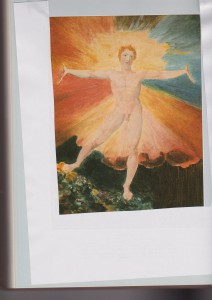(the art of presence and vitality: William Blake’s “Glad Day”)
Simply put, someone or something either is or isn’t. He, she, or it exists and has being or doesn’t. You’ll recall that life starts and ends that way in the form of presence or non-presence. In school, students were either present or absent (that is, not-present). A feeling went with that. One either felt like one was there (in class) or wasn’t (as we or someone else noted an empty desk). In some cases, we were the ones who were not present–at home with the mumps, skipping class, and so forth.
But with the experience of being absent from the group at school came another impression and that was that presence was a subjective state and that one could still experience presence and the presence of absent others and other situations even when in a changed scene or setting. Presence was potentially something one felt, imagined, and experienced all on one’s own.
As well, presence was not just something experienced in relation to environments. One could be thought of as a presence within a family, experiencing the presence of parents and siblings. Or one was aware of the presence of animals via owning a pet or visiting a zoo. Perhaps one experienced the presence of nature, as in the morning when stepping out into the freshness of morning air or when travelling to a memorable place such as the mountains or seaside. Poet William Blake said this best, perhaps: “To see a world in a grain of sand,/ And a heaven in a wild flower,/ Hold infinity in the palm of your hand,/ And eternity in an hour.” To know presence, then, is to connect and possibly transcend.
Most of us know, though, that presence is often or mostly transitory and ephemeral. And it is dependent ultimately on the presence of whichever people you choose to consider, including yourself. One day someone is there, another he or she is not, and connections and entire worlds are suddenly, conspicuously absent, vanished, or blotted out by absence, death or memory losses. There is great value, meaning, and purpose in the simple fact of lived, shared, and experienced presence, a fact often only fully known, understood, missed, and appreciated belatedly. As Joni Mitchell once put it, “you don’t know what you’ve got till it’s gone.”
……………………………………………………………………………………………..
No connection is possible without others, without presence. Wherever each of us is, our presence is capable of being experienced by others.
But do e-mails, text messages and social media network sites do justice to presence? (For one thing, they significantly omit the physical human voice which is our main, unique, expressive, identifying self.) Are they as good, strong, or personal as a phone call or a Skype communication (the latter with the extra advantage of mediated visual presence)? When it comes down to it, would you rather talk to someone via mediated electronic forms or spend time face-to-face with the presence of the same live in-person human being? What does live in-person presence give us that other mediated communications can’t?

